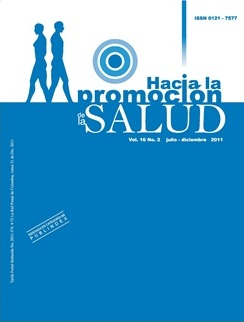Authors
Abstract
Objective: to develop and implement an interactive tool that provides a virtual experience in the field of neurological semiology and is conducive to achieve deep learning and improvement in the learning process of medicine students at Universidad de Caldas in 2010. Materials and methods: cohort observational analytical research with development of two computing tools: educational BLOG and CD with audiovisual material. Population: 52 medicine students at Universidad de Caldas who were taking the General Semiotics class in the first semester, 2010: 24 men and 28 women ages 18 to 24. Thirty students participated in the educational BLOG and 22 did not. Students were evaluated in three moments: at the beginning, in the middle and at the end of the semester. Four deep learning categories were evaluated in each moment: analytical ability, richness in technical vocabulary, conceptual competence and problem solving ability. Results: most of the students who participated in the BLOG had dominantly appropriate responses in each of the categories of deep learning. Conclusions: the use of a computing tool for neurological semiology teaching and learning proved useful as a facilitator in the acquisition of deep learning. The BLOG development allowed students to gain confidence at the moment of performing the patients’ clinical examination.
References
Badillo R. Problemas de Enseñanza Aprendizaje en Medicina. Soluciones académicas y computarizadas (Parte I). Acta Med Colomb 2003; 28(1):40-4.
Carrizosa J, Cornejo J. Enseñanza de la neurología en el pregrado médico. Acta Neurol Colomb 2003; 19(4):191-8.
Superintendencia Nacional de Salud. 20 minutos, tiempo mínimo de consulta médica: Superintendencia Nacional de Salud. 2005. [Citado 2010 Ago 23]. Disponible en URL: http://www.asmedasantioquia.org/momento_medico/edicion_86/supersalud
Youssef FF. Neurophobia and its implications: evidence from a Caribbean medical school. BMC Med Educ 2009; (9):39.
Eurolo J, Álvarez G. Enseñanza de la neurología en el pregrado: propuesta de una nueva metodología. Rev Chil Neuro-Psiquiatr 2004; 42(2):131-7.
Díaz R, Ruano M, Chacón A, Vera A. Perfil neuroepidemiológico en la zona centro del departamento de Caldas (Colombia): 2004 - 2005. Rev Neurol 2006; 43(11):646-52.
Telesalud Universidad de Caldas. Educación virtual. [Citado 2010 Sep 2]. Disponible en URL: http://telesalud.ucaldas.edu.co
Delgado M, Solano A. Estrategias Didácticas Creativas en Entornos Virtuales para el Aprendizaje. Actualidades Investigativas en Educación [serie en línea] 2009 [citado 2010 Sep 6]; 9(2):1-21. Disponible en URL: http://revista.inie.ucr.ac.cr
Barth L, Mariño S, Bonomo D. Construcción de un entorno virtual para el aprendizaje de la Embriología General Humana. Com Cient y Tecn 2004; 36:155-74.
Casado R. El aprovechamiento de las tecnologías de la información y la comunicación (TIC) para la creación de redes de aprendizaje colaborativo: La experiencia de Telefónica de España. [Citado 2010 Sep 3]. Disponible en URL: http://cvc.cervantes.es/obref/formacion_virtual/tele_aprendizaje/casado.htm
González M. NETCampus, una solución integral para la formación a distancia a través de sistemas virtuales. online educa Madrid 2000. [Citado 2010 Sep 8]. Disponible en URL: http://cvc.cervantes.es/obref/formacion_virtual/metodologia/arechabaleta.htm
Noa L, Gil J. El ABC de las nuevas tecnologías. Experiencias sobre un curso en la web. [Citado 2010 Sep 3]. Disponible en URL: http://cvc.cervantes.es/obref/formacion_virtual/metodologia/noa.htm
White RT, Mitchell IJ. Metacognition and the quality of learning. Studies in Science Education 1994;23:21-37.
Chin C, Brown DE. Learning in science: A comparison of deep and surface approaches. Journal of Research in Science Teaching 2000;37(2):109-38.
Olsher G, Beit BO. Biotechnologies as a context for enhancing junior high-school student’s ability to ask meaningful questions about abstract biological processes. International Journal Science Education 1999;21(2):137-53.
Sawyer RK. Introduction: The new science of learning. In: Sawyer RK, editor. The Cambridge handbook of the learning sciences. Cambridge: Cambridge University Press; 2006. p.1-16
Pardo N. Lecciones de Semiología Neurológica. 1ra ed. Manizales: Centro Editorial Universidad de Caldas; 2005.
Tamayo O. Teorías pedagógicas: relaciones entre la pedagogía y la didáctica [Tesis de Maestría]. Manizales: Universidad de Caldas; 2008.
Farell, G. El desafío de las nuevas tecnologías de la información y las comunicaciones para los docentes de la educación médica. Rev Cubana Educ Med Super 2002; 16(1):37-46.
Zinchuk AV, Flanagan EP, Tubridy NJ, Miller WA, McCullough LD. Attitudes of US medical trainees towards neurology education: “Neurophobia” - a global issue. BMC Medical Education 2010;10:49.
Coll C, Monereo C. Psicología de la educación virtual: aprender y enseñar con las tecnologías de la información y la comunicación. 1ª ed. Madrid: Morata SL; 2008.


 PDF (Español)
PDF (Español)
 FLIP
FLIP






















